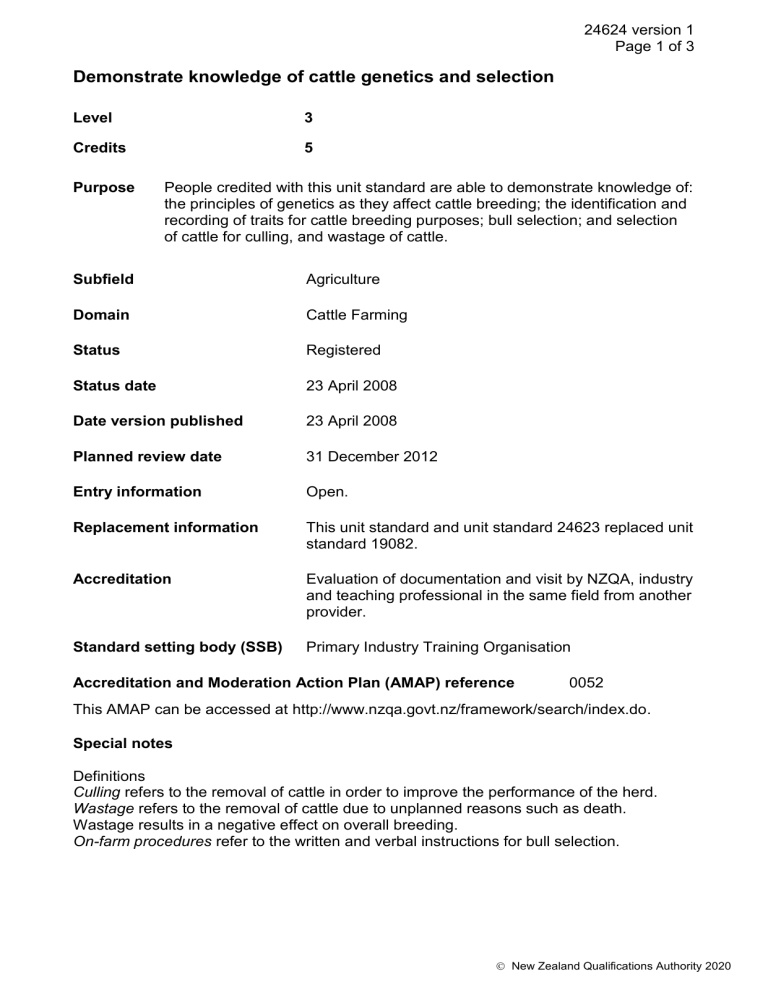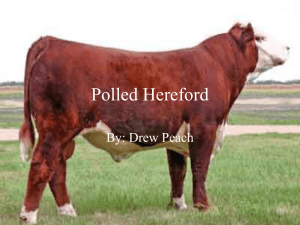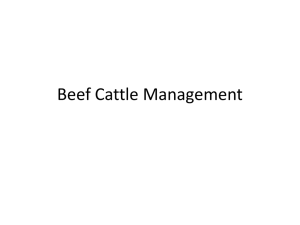24624 Demonstrate knowledge of cattle genetics and selection

24624 version 1
Page 1 of 3
Demonstrate knowledge of cattle genetics and selection
Level 3
Credits 5
Purpose People credited with this unit standard are able to demonstrate knowledge of: the principles of genetics as they affect cattle breeding; the identification and recording of traits for cattle breeding purposes; bull selection; and selection of cattle for culling, and wastage of cattle.
Subfield Agriculture
Domain
Status
Status date
Date version published
Cattle Farming
Registered
23 April 2008
23 April 2008
Planned review date
Entry information
31 December 2012
Open.
Replacement information
Accreditation
This unit standard and unit standard 24623 replaced unit standard 19082.
Evaluation of documentation and visit by NZQA, industry and teaching professional in the same field from another provider.
Standard setting body (SSB) Primary Industry Training Organisation
Accreditation and Moderation Action Plan (AMAP) reference 0052
This AMAP can be accessed at http://www.nzqa.govt.nz/framework/search/index.do.
Special notes
Definitions
Culling refers to the removal of cattle in order to improve the performance of the herd.
Wastage refers to the removal of cattle due to unplanned reasons such as death.
Wastage results in a negative effect on overall breeding.
On-farm procedures refer to the written and verbal instructions for bull selection.
New Zealand Qualifications Authority 2020
24624 version 1
Page 2 of 3
Elements and performance criteria
Element 1
Demonstrate knowledge of the principles of genetics as they affect cattle breeding.
Performance criteria
1.1 Genetic gain is described in terms of its application to cattle breeding and production improvement.
1.2 The nature and role of genes and chromosomes are described in terms of sex determination, heredity, traits, and cell division.
1.3 Heredity and environment are differentiated and described in terms of their influence on genetic improvement.
1.4
Element 2
The normal distribution curve is described in terms of its use in breeding programmes.
Demonstrate knowledge of the identification and recording of traits for cattle breeding purposes.
Performance criteria
2.1 The identification of desirable traits is described in terms of productive value, ease of management, visual and structural characteristics.
Range must include – temperament, structural soundness; beef cattle includes but is not limited to – estimated breeding value
(EBV), growth rates; dairy cattle includes but is not limited to
– breeding worth, production worth, lactation worth; evidence is required for either beef cattle or dairy cattle.
2.2 Desirable traits are described in terms of their measurement and recording.
Range types, unit and methods of measurement, desirable trait ranges, recording systems.
Element 3
Demonstrate knowledge of bull selection.
Performance criteria
3.1 Ideal physical features of bulls are described in accordance with on-farm breeding procedures.
New Zealand Qualifications Authority 2020
24624 version 1
Page 3 of 3
3.2 Breeding values for bulls are described in terms of the important features.
Range may include but is not limited to – carcass attributes; EBV’s: birth weight, reproductive performance, growth rates; evidence is required for at least two.
3.3 Information for bull purchase is described in terms of the sources available.
Range includes but is not limited to – agent or representatives, breeders, publications.
Element 4
Demonstrate knowledge of the selection of cattle for culling, and wastage of cattle.
Performance criteria
Culling and wastage are described in terms of livestock farming practice. 4.1
4.2 The effects of culling and wastage of cattle are described as they influence cattle breeding.
4.3 The number of replacements needed is calculated from given culling and wastage figures.
Please note
Providers must be accredited by NZQA, or an inter-institutional body with delegated authority for quality assurance, before they can report credits from assessment against unit standards or deliver courses of study leading to that assessment.
Industry Training Organisations must be accredited by NZQA before they can register credits from assessment against unit standards.
Accredited providers and Industry Training Organisations assessing against unit standards must engage with the moderation system that applies to those standards.
Accreditation requirements and an outline of the moderation system that applies to this standard are outlined in the Accreditation and Moderation Action Plan (AMAP). The
AMAP also includes useful information about special requirements for organisations wishing to develop education and training programmes, such as minimum qualifications for tutors and assessors, and special resource requirements.
Comments on this unit standard
Please contact the Primary Industry Training Organisation standards@primaryito.ac.nz if you wish to suggest changes to the content of this unit standard.
New Zealand Qualifications Authority 2020








